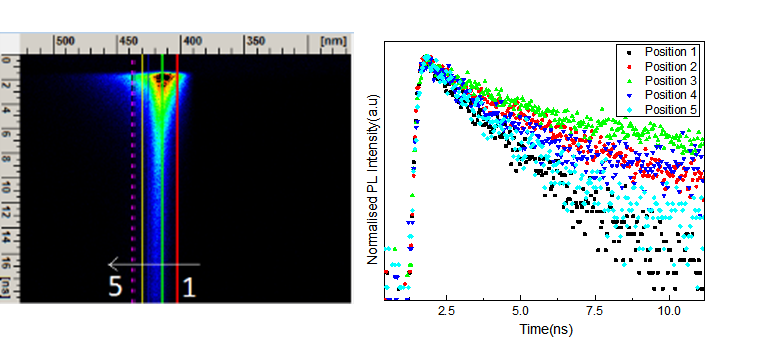Investigating the carrier dynamics of emerging wide band gap semiconductor for novel optoelectronic applications

Project Details
Program
Marine Science
Field of Study
Optical spectroscopy of semiconductors
Division
Physical Sciences and Engineering
Faculty Lab Link
Project Description
Studying fundamental sciences is the key factor for technological development, as this allows the researchers to better understand the natural phenomena behind human discoveries. In the context of semiconductor innovation, for example, the physics principles of carrier recombination and the importance of quantum mechanics, including carrier quantum confinement, localization, and their effects on the carrier wavefunction, need to be studied in order to ensure efficient semiconductor-based devices. Mainly, technology based on wide bandgap semiconductors as high-energy optoelectronics based on these materials that operate at the deep UV and UV spectral ranges got scientists attention due to their use for many applications in different fields, such as medical treatment, astronomy investigations, material analysis, missile detection, space communications, security systems, and x-ray imaging.
Due to the lack of suitable substrates, the emitting devices still need further enhancement. For example, no commercial laser diode operates in the UV spectral range below 375 eV. Therefore, in this project, this issue will be addressed to enhance the emission of these materials. The project will focus on studying the fundamental physics of the carrier dynamics of wide-bandgap semiconductors such as III-nitrides and oxides. Several structures will be investigated experimentally and theoretically for developing wide bandgap semiconductor-based materials, one of which is carrier confinement using different novel approaches. The project goals will be achieved by employing time-integrated photoluminescence (PL) using CW lasers as well as time-resolved PL using ultrafast oscillators attached to streak camera or photon-counting detection systems. In addition, PL excitation will be used to understand the origin of the emitted light using a Xe lamp attached to a fluorescence system. The theoretical simulation of emitting devices will be carried out by analytical code, such as Lumerical.
About the Researcher
Iman Roqan
Assistant Professor, Material Science and Engineering
Affiliations
Education Profile
- Ph.D., Semiconductor Spectroscopy, University of Strathclyde, 2008
- M.S., Photonics and Optoelectronics Devices, Heriot-Watt University and University of St Andrews, 2002
- B.S., Physics and Education, Umm Al-Qura University, 1999
Research Interests
Professor Roqan's research interests include optical, magnetic and structural properties of wide bandgap semiconductors (mainly ZnO and GaN related materials), with an aim to improve the quality of the grown films and their luminescence and ferromagnetic properties. She uses energy-dispersive and wavelength-dispersive x-ray spectroscopy, as well as atomic force microscopy to characterize the materials and their surface morphologies Roqan's group is semiconductor and material spectroscopy group. Optical spectroscopy could identify the carrier mechanism such as carrier confinement behavior, quantum stark effect, carrier density and carrier injection. Moreover, we could also identify the effect of the width of the quantum well/barrier, the effect of the nanorod structure, the bandgap structure, the polarization effect, the interaction of defect bands in the spectra and the identification of their source by time-resolved spectroscopy (TRS), photoluminescence (PL) and photoluminescence excitation (PLE). Second and third Harmonic Generator and OPO facilities add additional laser tunability and allow us to carry out PLE and selective TRS measurements simultaneously. They use XRD, SQUID and SEM to study the structural characterizations. They study the role of defects and material structure on the optical, magnetic and structural properties of the materials that lead to understanding the behavior of the materials and optimizing the material/device structures.Selected Publications
- Ajia, I. A., Edwards, P. R., Liu, Z., Yan, J. C., Martin, R. W., & Roqan, I. S. (2014). Excitonic localization in AlN-rich AlxGa1aˆ’ xN/AlyGa1aˆ’ yN multi-quantum-well grain boundaries. Applied Physics Letters, 105(12), 122111.
- Zhang, Z., SchwingenschlA¶gl, U., & Roqan, I. S. (2014). Vacancy complexes induce long-range ferromagnetism in GaN. Journal of Applied Physics, 116(18), 183905.
- Muhammed, M. M., Peres, M., Yamashita, Y., Morishima, Y., Sato, S., Franco, N., ... & Roqan, I. S. (2014). High optical and structural quality of GaN epilayers grown on (2A¯ 01) I²-Ga2O3. Applied Physics Letters, 105(4), 042112.
- Miranda, S. M. C., Edwards, P. R., O'Donnell, K. P., BoA‡kowski, M., Alves, E., Roqan, I. S., ... & Lorenz, K. (2014). Sequential multiple-step europium ion implantation and annealing of GaN. Phys. Status Solidi C, 11(2), 253-257.
- Lorenz, K., Miranda, S. M. C., Alves, E., Roqan, I. S., O'Donnell, K. P., & BoA‡kowski, M. (2012, February). High pressure annealing of Europium implanted GaN. In SPIE OPTO (pp. 82620C-82620C). International Society for Optics and Photonics
- Melnikov, V. A., & Roqan, I. S. (2012, November). Lineshape Engineering in an All-Pass Ring Resonator with Backreflection Coupled to a Symmetrical Fabry-Perot Resonator. In Latin America Optics and Photonics Conference (pp. LT4B-2). Optical Society of America.
- Roqan, I. S., O'Donnell, K. P., Martin, R. W., Edwards, P. R., Song, S. F., Vantomme, A., ... & BoA‡kowski, M. (2010). Identification of the prime optical center in GaN: Eu 3+. Physical Review B, 81(8), 085209.
Desired Project Deliverables
- Be familiar with advanced optical spectroscopy techniques
- Understanding the fundamentals of optical properties of semiconductor
- Understanding the carrier dynamics of semiconductor
- Achieving theoretical and experimental results of the novel semiconductor structure
- Analyzing the carrier dynamic outputs
- Finally, concluding the desired projects
Recommended Student Background
Physics
Optics
Materials science
Electric engineering
We are shaping the
World of Research
Be part of the journey with VSRP
3-6 months
Internship period
100+
Research Projects
3.5/4
Cumulative GPA
310
Interns a Year